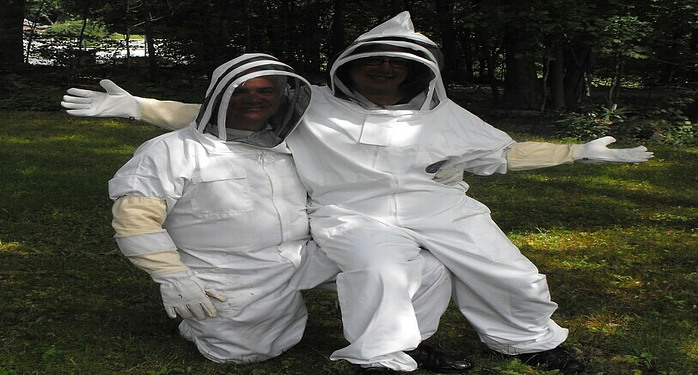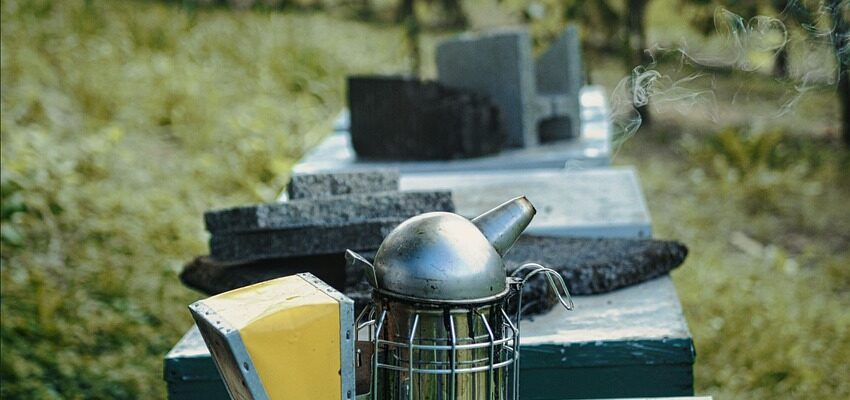I’m going to kick things off with a simple truth: beekeeping is as rewarding as it is challenging. This ancient practice not only yields delicious honey but also plays a pivotal role in sustaining our ecosystems by aiding in pollination. That’s why it’s crucial for novices to get acquainted with the essential beekeeping gear that’ll pave the way for a fruitful beekeeping journey.
You’re going to find out about the core items every beekeeper should have. Whether it’s selecting the right hive or protecting yourself with the proper attire, each piece of equipment has a specific purpose. This isn’t just about convenience; it’s also about efficiency and, most importantly, safety.
Don’t worry too much about the cost at first. There’s a lot of opportunity in beekeeping, and choosing something that resonates with you and fits your budget is better than not starting at all. As you learn and grow into the hobby, you can always adjust your approach down the road, investing more in equipment that lasts and performs well.
In my opinion, starting with the basics is key. It ensures you’re not overwhelmed and allows you to understand the role of each tool.
Then, when we transition into the specifics of protective clothing next, you’ll see just how each piece of equipment and clothing works together to keep you safe as you delve into the world of bees.
Protective Clothing: Safety as a Top Priority
I’m going to level with you; beekeeping is an incredibly rewarding activity, but stings are part and parcel of the experience.
That’s where the right protective clothing comes into play. It’s not just about avoiding discomfort; it’s also about ensuring that you can manage your hive with confidence and safety.
You’re going to find out about the essentials, including bee suits, gloves, and veils. Each serves a unique purpose and offers a different level of protection. A full-body bee suit with a built-in veil can be your best defense against stings, while gloves keep your hands safe and let you handle the frames with precision.

However, if you aren’t afraid of a sting or two, just a beekeeping jacket with some jeans and close-toed shoes will work, too.
Materials matter here. Bee suits are often made of light-colored, smooth-textured materials that make it hard for bees to get a grip and sting.
Ventilated suits might be a tad more expensive, but they are worth every penny if you’re working in warmer climates.
Veils come in different forms: from round hats with a hanging net to hoods that zip onto your bee suit. Choose something that resonates with you in terms of comfort and visibility.
And don’t forget to secure the bottom of your suit, either with a snug fit around the ankles or by tucking it into your boots. Honey bees do have a tendency to crawl up your pant legs.
As for gloves, leather is a favorite because it’s tough and durable. Just don’t focus too much on perfection; beekeeping gloves should be thick enough to prevent stings but still allow you some tactile sensation.

Once you’ve become comfortable, you can learn how to keep bees without any gloves.
Lastly, taking care of these garments is just as important as choosing the right ones. Regular cleaning and careful storage will extend their lifespan and effectiveness. It also helps to prevent the spread of diseases from one hive to another.
Remember, your first attempt at finding the perfect set doesn’t need to be your last—you can always adjust your approach down the road.
Tools of the Trade: The Hive, Smoker, and More
Your new beekeeping adventure isn’t just about staying sting-free; it’s also about mastering the essential tools that keep your buzzing friends happy and your honey production flowing. Think of these tools as an investment in your apiary’s future.
Choosing the right hive is like picking a house for your family – it needs to be comfortable, roomy, and safe. You might start with a traditional Langstroth hive, known for its stackable design and ease of inspection, but top-bar or Warre hives are great alternatives that support natural bee behaviors.
No beekeeper’s toolkit is complete without a smoker, a crucial device for calming your bees during hive inspections. Not only does smoke calm bees by masking alarm pheromones, it also triggers a feeding response that makes them less likely to sting. The key is to use it sparingly and effectively – you’re going for a gentle puff of smoke, not a barbecue!

Now let’s talk about the other tools that should be hanging in your shed. A hive tool is like the Swiss army knife of beekeeping; it helps you pry apart hive components that bees have glued together with propolis.
You’ll also need feeders for supplying sugar syrup or fondant during lean times, and extractors are critical when it’s time to harvest honey without destroying the hive.
After mastering these tools, you’re ready for the next step: scaling up your beekeeping enterprise, which I’ll dive into soon.
Remember, as your hive grows, so does your knowledge and experience. Investing wisely in these tools sets the stage for a flourishing beekeeping practice that can bring you joy and sweet rewards for years to come.
Investing in Beekeeping: Long-Term Success and Expansion
I’m going to level with you: investing in beekeeping isn’t just a hobby, it’s a commitment to these essential pollinators and the environment.
When you choose gear that’s built to last, you’re setting yourself up for success. And let’s not beat around the bush, quality equipment can indeed be pricier, but it pays off.
You probably know this, but beekeeping isn’t static. Like any skill, it grows and evolves with you. As your apiary expands, so will your needs. That’s why it’s smart to plan for the future now. Choose equipment that can grow with your hive count and can handle the additional workload.
Continuous learning is key in beekeeping. The industry is always buzzing with new techniques and discoveries. By staying informed and adaptable, you can incorporate innovative methods that benefit your bees and yield.
And you know what? Connecting with a community of beekeepers can make a world of difference.

Sharing experiences and advice with others is invaluable. Trust me, their insights often lead to breakthroughs in how you manage your hives. Just also keep in mind you may get a lot of different views and suggestions, too.
In my opinion, beekeeping is one of the most rewarding endeavors you can pursue. It requires patience, care, and a bit of bravery, but the payoff is undeniable. Not just in the sweet honey or the improved garden pollination, but in the knowledge that you’re making a positive impact.
The significant role that bees play in our lives is crucial, more now than ever before. It makes learning about them just as important, too!
So I really hope that you consider these points as you deepen your beekeeping journey. Remember, your choices today shape the hive of tomorrow. Choose something that resonates with you and your goals. Buzz on, and may your hives thrive!

2 comments on “Essential Equipment For Beekeeping”
Ronald
January 27, 2024 at 2:48 amI really appreciate how this article covers all the essential equipment needed for successful beekeeping. The detailed explanations and descriptions of each item make it easy to understand their importance and how they contribute to the overall management of beehives. You also provided valuable insights into the different types of protective gear and tools, which is crucial for ensuring both the safety of the beekeeper and the well-being of the honeybees.
Thank you for this excellent resource!
Randi
January 28, 2024 at 9:34 pmHi Ronald! Thank you for your response! I’m glad you found it as a good resource for beekeeping equipment.